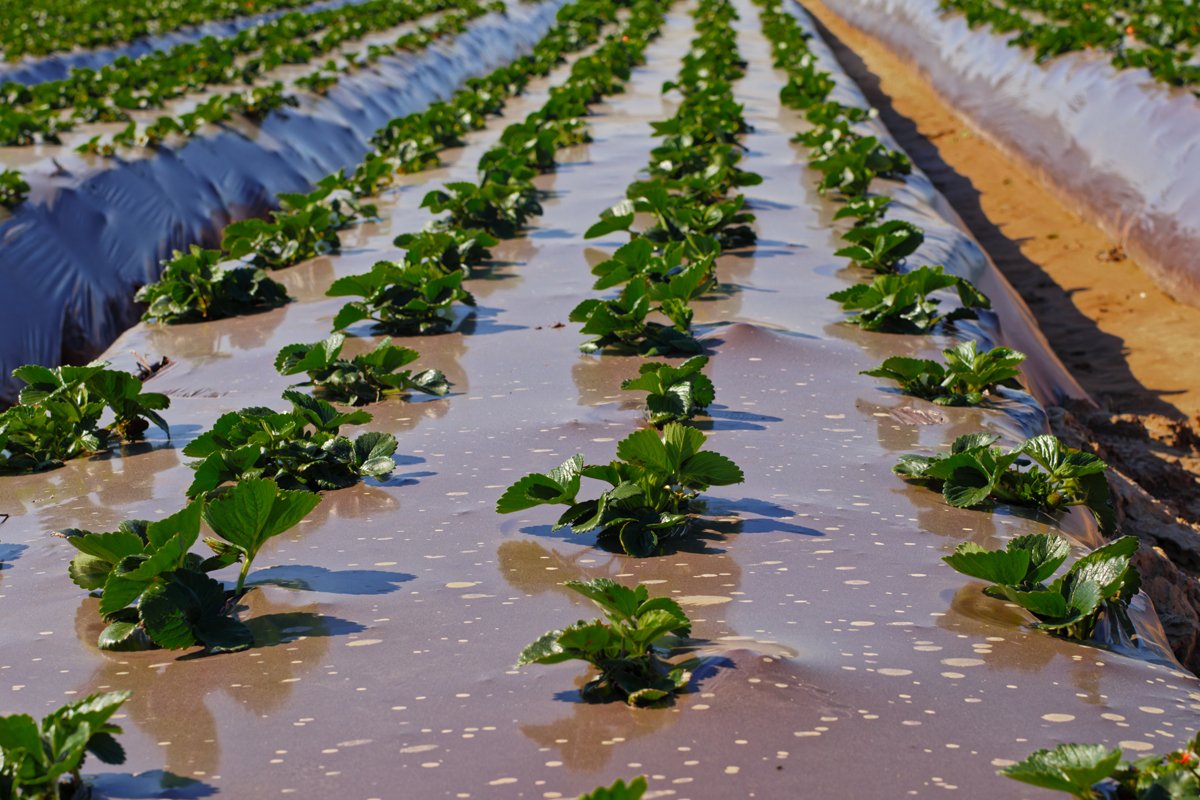U.S. farms are covered in plastic, from the sides of greenhouses to plastic mulch, hoop houses, irrigation tubes, and more. As it degrades, plastic accumulates in soil and in plants, with potential threats to food safety.

U.S. farms are covered in plastic, from the sides of greenhouses to plastic mulch, hoop houses, irrigation tubes, and more. As it degrades, plastic accumulates in soil and in plants, with potential threats to food safety.
June 5, 2024

Rows of plastic-covered strawberry plants.
A version of this article originally appeared in The Deep Dish, our members-only newsletter. Become a member today and get the next issue directly in your inbox.
In 1948, E.M. Emmert, a horticulturist at the University of Kentucky, was tinkering around with how to build a cheap greenhouse. He decided to use polyethylene sheets in lieu of the glass sides, bending the plastic film around a wooden frame. The plants thrived in the new environment; the plastic let in enough light while trapping in warmth.
This is commonly regarded as the first introduction of plastic into agriculture, a move that would transform modern farming—and inadvertently deposit an untold amount of plastic in the soil.
In the decades that followed, this cheap, pliant material spread through farms across the U.S. and world, becoming so widely used that plastics in agriculture gained its own name: plasticulture.
“Everything that we create as humans degrades to some degree over time. That’s the reason we’re facing such a massive issue.”
Today, it’s common to see farms covered in plastic. It lines the sides of greenhouses, blankets fields as “plastic mulch,” covers hoop houses, and winds through farms as irrigation tubes, among other forms. In satellite images, the National Aeronautics and Space Administration (NASA) has observed the typically golden and green agricultural fields turned white, as though dusted in snow, from all of the plastic.
Agriculture is responsible for 3.5 percent of global plastic production, a figure that may seem small until you consider the sheer volume of plastics produced: around 400 million metric tons per year.
Little did Emmert know that this plastic was also degrading over time, breaking down into tiny flakes and accumulating in the soil. Microplastics pervade every part of the Earth, from the bottom of the ocean floor to all forms of drinking water to the human placenta. Complicating matters, plastic doesn’t decompose; instead, it turns into smaller and smaller bits of plastic, eventually becoming invisible nanoplastics. A recent paper called the enormity of tiny plastic litter a “menace to the biosphere.”
“Everything that we create as humans degrades to some degree over time. That’s the reason we’re facing such a massive issue,” said Samuel Cusworth, a recent PhD graduate from the University of Lancaster in England, who focuses on microplastics in the soil. “And once they’re in the environment, they’re very hard to retrieve.”
The Earth’s soils have become a waste bin of the world’s plastics. Soil is thought to be even more polluted with microplastics than the ocean, which contains an estimated 358 trillion plastic particles. Agricultural soils have been called a “reservoir” for not just the plastic produced on farms, but also plastics from other industrial sources that enter the water to eventually wash up on farms during a flood, or are carried by the wind. In a world where all industries run on plastics, these fine particles can also find their way onto farms through poultry litter, sewage sludge applied to soils, and even fertilizer.
“There are currently no viable remediation techniques,” said Cusworth. “If you want to remove them from the soil, [the solution] is to stop producing them in the first place.”
The major producers of plastics, like ExxonMobil and Dow, continue to sell plastic to farmers as a way to adapt to extreme weather conditions like drought and flooding. For instance, ExxonMobil promises that plastic sheets, like those used by Emmert, will “protect and preserve harvests in even the most demanding weather conditions.” Yet the production of plastics—a derivative of fossil fuels, typically obtained through fracking—is a major contributor to climate change, responsible for over 5 percent of global emissions.
This creates a vicious cycle, where the production of plastic drives climate change, which drives up demand for plastics on farms. Extreme weather also causes plastics to degrade more quickly, causing microplastic litter. Indeed, a 2021 report from the United Nations’ Food and Agricultural Administration noted that the demand for plastic on farms is projected to grow by 50 percent between 2018 and 2030.
Scientists are still trying to understand how microplastics in the soil impact global food systems and food quality. They do know, however, that microplastics can “greatly change the structure of the soil,” as a review study put it, possibly affecting the cycling of nutrients, the retention of moisture, the storage of carbon, and the overall climate adaptability of a farm.
Nearly every farmer will tell you that healthy soil is the foundation of a healthy farm. And studies have found that microplastic particles in the soil can enter plant tissues—through either the roots or the pores on the leaves—and disrupt the plant’s growth. Plastics can even accumulate in the edible parts of the plant, like its fruits and leaves, potentially threatening food safety.
Unfortunately, most farmers are not aware of how much plastic is in their soil, because tests are not widely available.
Cusworth recently conducted the first nationwide assessment of soil microplastics in Europe. He sampled soil from fields of carrots and potatoes across England, comparing farms that utilized plastic sheets to those that hadn’t used these sheets in at least 10 years. He found that all soils sampled contained microplastics, another indicator of agricultural soil serving as a sink for microplastics.
“It was quite shocking to see how high these concentrations are, even without the [recent] use of plastic,” said Cusworth. “That really surprised us.”
Despite the persistent presence of plastics in agriculture, cutting down on their use can still make a substantial difference in the load of plastic in the soil, noted Cusworth. He found that the farms that utilized plastic sheets contained, on average, a staggering 75 percent higher concentration of microplastics in the soil compared to farms without the sheets.
Unfortunately, most farmers are not aware of how much plastic is in their soil, because tests are not widely available. “That’s something that I’ll hopefully be working on in the next two years—a standardized approach [to microplastic soil sampling],” Cusworth said.
He noted, however, that most of the farmers he worked with in the study were really engaged, giving him hope that ingrained use of plastics on farms can begin to shift. “It would be interesting to see how they may change their practices going forward,” he added.
While there are no remediation methods, farmers may be able to reduce the amount of plastic that enters the soil through “going back to more traditional techniques of farming to work with the environment rather than against it,” said Cusworth. For instance, relying less on tractors and heavy machinery would create “less opportunity for rubber tires to degrade and get into the soil,” he said.
The United Nations’ Food and Agriculture Organization also recommends shifting farming practices to minimize plastics, including replacing plastic irrigation drip tape with a more durable or permanent irrigation system. They advise farmers to return to organic sources of mulch or cover cropping to replace plastic mulch, the plastic sheets placed directly on the soil to suppress weeds and retain moisture. They also recommend a return to glass greenhouses, while launching incentive schemes to support these transitions.
There’s also a potential solution in bioplastics, which can break down into organic material. Yet there’s a major catch: It needs to be collected and composted properly. Otherwise, it will wind up in a landfill for perhaps centuries, much like regular plastic.
In general, “we need to use [plastic on farms] more sustainably,” said Cusworth, “making sure that it’s not used wastefully, and that it’s collected and processed properly, in the most environmentally friendly way possible.”

September 4, 2024
By paying top dollar for milk and sourcing within 15 miles of its creamery, Jasper Hill supports an entire community.
September 3, 2024

August 27, 2024

August 26, 2024

August 13, 2024

Like the story?
Join the conversation.